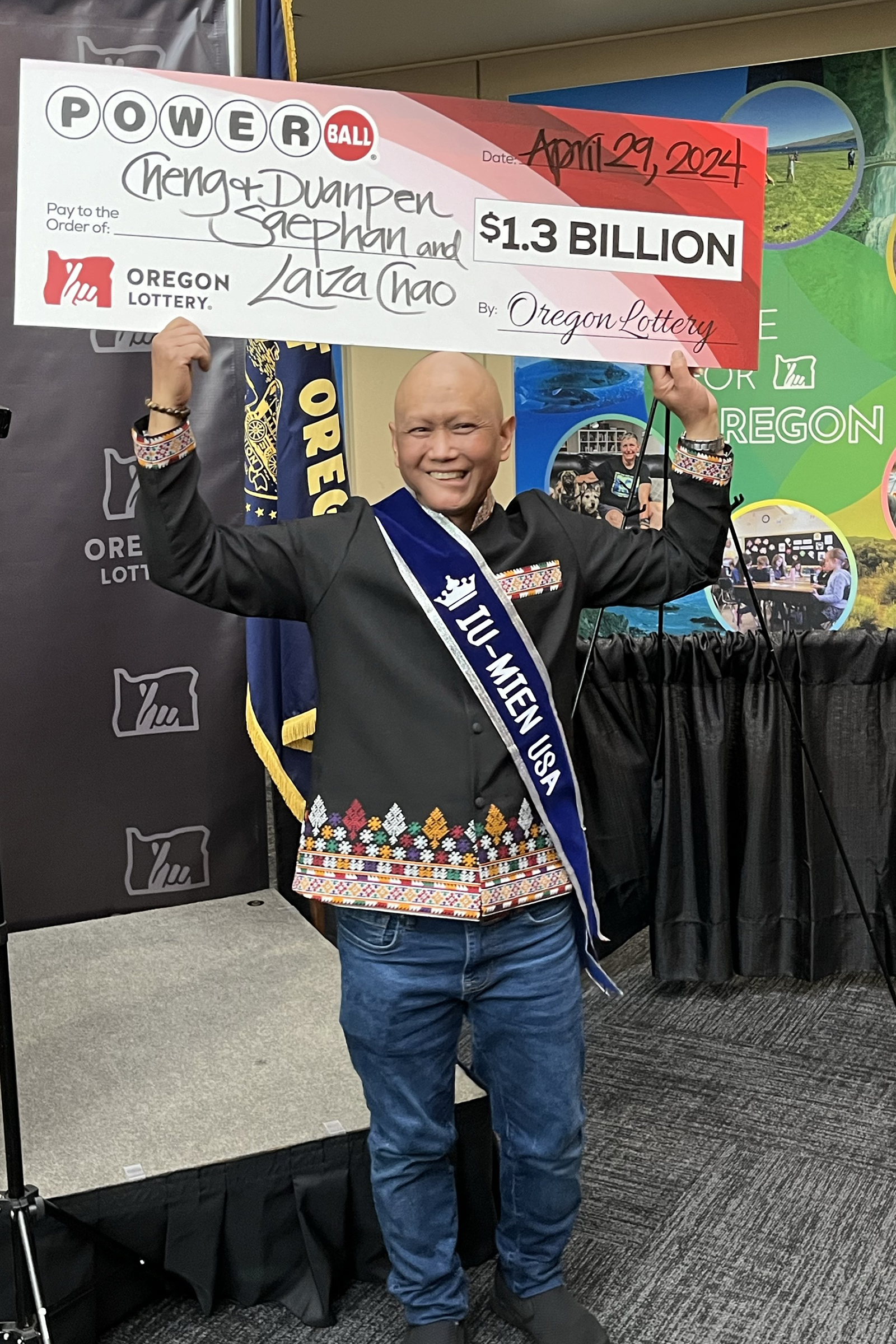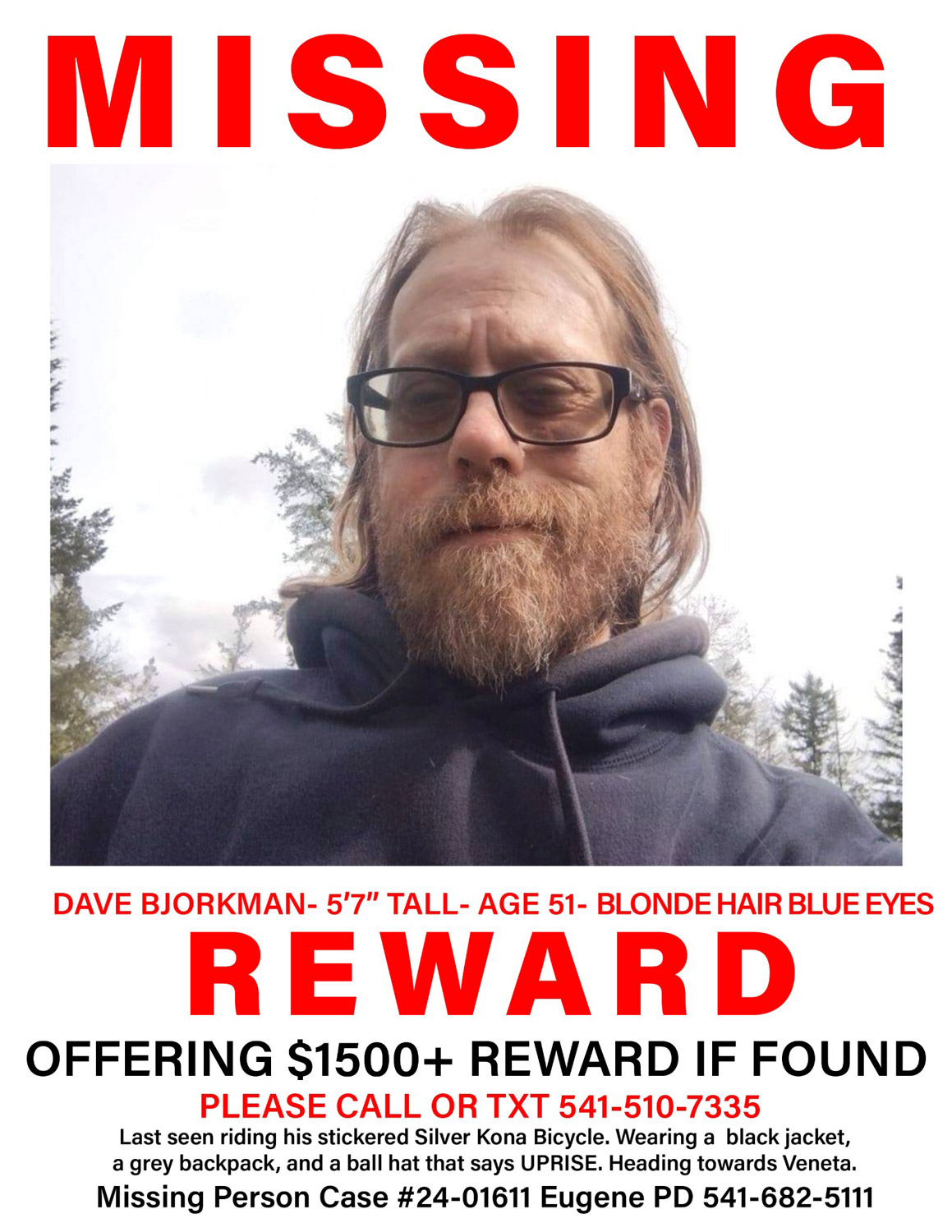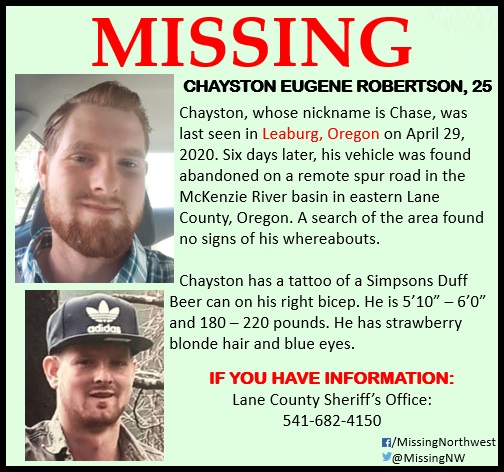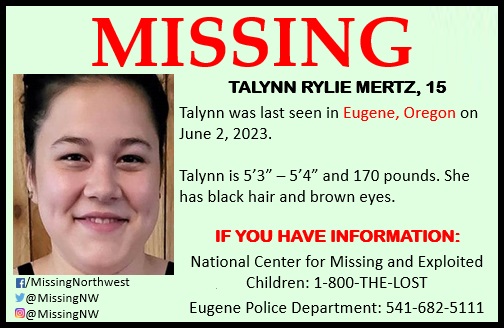The latest news stories and stories of interest in the Willamette Valley from the digital home of Southern Oregon, from Wynne Broadcasting’s WillametteValleyMagazine.com
Wednesday, May 1, 2024
Willamette Valley Weather



Amtrak Experiencing Record Ridership From Eugene To Portland


The Amtrak Cascades saw 14,263 riders in March on the section of the route that runs between Eugene and Portland. That’s a 57% increase over the same month last year. It’s also the best month the route has had in its 30-year history.

Shelley Snow with the Oregon Department of Transportation said Spring Break contributed to their record month. But there are other reasons for the boost, including high gas prices and a recent schedule change.
“We have improved the service on the train going northbound out of Eugene,” she said. “The train used to leave at 5:30 a.m. Now it leaves at 7:45 a.m. and we are absolutely seeing more riders on that 7:45 a.m. northbound.”
Snow acknowledged the train is not always on time. She said it’s usually a better bet to take the train if you don’t have time constraints.
Shelley said in 2023, they saw seven months in a row of more than 10,000 riders per month.
“So, we’re back,” she said. “Passenger rail service is back in Oregon and we’re psyched about that. We hope that people who’ve never taken the Amtrak Cascades train will give it a try.”
Amtrak Cascades is operated as a partnership between ODOT, the Washington Department of Transportation and Amtrak. Its trains run daily between Eugene and Vancouver, B.C. https://www.facebook.com/AmtrakCascades
Man arrested after trying to break into ATMs

At around 2:29 a.m. on April 30, Eugene Police were notified of a burglary in progress at 13th Avenue Market, 410 W. 13th Avenue. When they arrived at the store, they spotted the suspect through the front windows and saw he was trying to break into an ATM. The suspect became aware police had arrived and went into hiding.
Along with officers, there was a K9 unit and an officer operating a drone. The drone footage helped officers safely check inside and figure out where the suspect was hiding, locked in a bathroom in the back of the store. After several attempts failed to get him to come out using commands, officers deployed OC into the bathroom and the suspect came out. Officers took him safely into custody. The doors to the building and two ATM machines were damaged.
The suspect, Joseph Patrick Woods, age 44, was transported to Lane County Jail on charges of Burglary in the Second Degree, Criminal Mischief in the Second Degree, and Possession of Burglary Tools. Case 24-06112
LCSO Case #24-2193 – Victim rescued, suspect arrested after pursuit
On April 29th at about 3:30am., the Lane County Sheriff’s Office received a report of a possible kidnapping. Deputies were able to track the involved suspect vehicle to the area of Veneta. Deputies attempted to stop the vehicle, but it fled east on Highway 126 and then south on Crow Road.
The victim was able to communicate she was in the vehicle during the pursuit.
The vehicle turned up a private driveway and a deputy conducted a PIT maneuver, disabling the vehicle and enabling the victim to escape.
Deputies arrested Christopher Forrest Stechelin, 29, and lodged him at the Lane County Jail on charges of Elude by Vehicle, Reckless Driving, Reckless Endangering, Coercion, Attempted Unlawful Use of a Vehicle, Robbery in the Third Degree, and False Information to a Peace Officer. Stechelin was also arrested on an Oregon State Parole Board warrant.
Monmouth Man Sentenced to Federal Prison for Role in Fatal Fentanyl Overdose of a Teenager
A Monmouth, Oregon man was sentenced to federal prison today for distributing fentanyl that caused the overdose death of a teenager in Salem, Oregon.
Javen James Pedro, 21, was sentenced to 75 months in federal prison and six years’ supervised release.
According to court documents, on February 24, 2022, officers from the Salem Police Department responded to an overdose of a 15-year-old teenager. Paramedics quickly transported the teen to a local hospital where he died. Further investigation revealed that on the previous day, the minor victim had purchased and consumed counterfeit Oxycodone pills containing fentanyl in front of several other juveniles. Investigators also obtained video surveillance footage from a neighbor showing the minor victim completing what appeared to be a drug transaction with a person determined to be Pedro.
Later on February 24, investigators located and arrested Pedro in Monmouth and he admitted to selling ten counterfeit Oxycodone pills to the minor victim the day prior. Pedro further admitted to selling pills to the minor victim approximately five to ten times previously.
On February 24, 2022, Pedro was charged by criminal complaint with distributing fentanyl. Later, on March 17, 2022, a federal grand jury in Portland indicted Pedro on the same charge.
On February 6, 2024, Pedro pleaded guilty to a one-count superseding criminal information charging him with distributing a controlled substance to a person under the age of 21.
This case was investigated by the Salem Police Department. It was prosecuted by Scott M. Kerin, Assistant U.S. Attorney for the District of Oregon.
LCSO CASE #24-2138 – Male arrested after shooting during dispute
On April 25th at about 8 p.m., Lane County Sheriff’s Office deputies responded to a report of a dispute with shots fired in the 49200 block of McKenzie Highway. Deputies responded and determined the victim had been transported to the hospital after being shot by a handgun.
Deputies arrested Daniel Dwayne Hernandez, 42, on charges of Assault in the Second Degree, Unlawful Use of a Weapon, Menacing APA, and Unlawful Use of a Weapon. Hernandez was lodged in the Lane County Jail on 4/25. He was arraigned while in custody on 4/26 and released by the Circuit Court on an electronic monitoring program on 4/27 after posting bail.
Jerry Bruce Community Campus Non-profit Partners to Hold Second Annual Spring Family Fair and First-ever Charity Golf Scramble
ROSEBURG, Ore. – Jerry Bruce Community Campus (JBCC) partner organizations Family Development Center, The FISH Food Pantry, Umpqua Homes, Inc., United Community Action Network, and Aviva Health are holding the second annual Spring Family Fair Saturday, May 4, from noon to 3 p.m. in the Aviva Health parking lot just north of Costco in Roseburg.

This year, event organizers have also added a charity golf scramble to the weekend activities, which takes place Sunday, May 5, with a 9 a.m. shotgun start at Bar Run Golf & RV Resort.
Proceeds from the weekend events, whose title sponsor is Umpqua Health, benefit JBCC partner organization UHI, which offers a variety of important programs and services to community members with differing abilities.
The Spring Family Fair features fun, free activities for children and adults including an obstacle course, henna tattoos, face painters, balloon art, and performances by Halau Hula Aulani and a local belly dancing club, among others. Food is available for purchase from Wailani Shave Ice, Relished Dog, Best Lemonade in Town, and Granny’s Mini Hut.
Sunday’s golf scramble, which is already sold out, will offer cash prizes to the top three low-score teams, and players will also have a chance to win $5,000 should they score an ace on the par-3 15th hole.
Last year’s inaugural Spring Family Fair was attended by more than 1,000 community members, and organizers are hopeful for an even better turnout for 2024.
ABOUT THE JERRY BRUCE COMMUNITY CAMPUS — In the early 2000s, Jerry Bruce and a cadre of like-minded community leaders had a vision for a non-profit community campus that was home to a variety of community-based organizations, each providing programs and services to address over-represented needs in the community.
Jerry set in motion a planning and fundraising effort that quickly gained traction in the community, allowing for the purchase of land on the north end of Stephens Street in Roseburg.
Today the campus is home to Family Development Center, FISH Food Pantry, UHI, UCAN, and Aviva Health. Together, the non-profit organizations offer programs that strengthen families, prevent child abuse, address food insecurity, support people with intellectual and developmental disabilities, childcare, address economic disparities, and fully integrated, comprehensive health care.
True to Jerry’s vision, the organizations work collaboratively to ensure Douglas County residents – irrespective of the challenges they may face – have a one-stop-shop solution for the myriad challenges they face, empowering them to live better, stronger, healthier, and stable lives. — Aviva Health
UPDATE Officer Involved Shooting on I-5 Update
Albany Police –
On Sunday, April 28, 2024 at approximately 6:25p.m., Linn County Sheriff’s Office and Oregon State Police were involved in an officer involved shooting on I-5 near exit 226, south of Tangent. Earlier in the afternoon, at approximately 3:00 p.m., two suspects, Cameron James Bielman, age 30 and Yasmina Destinee Teal, age 30, both of Anacortes, Washington were involved in a shooting in Coburg, Or. This shooting critically injured one male. The two suspects fled the area and allegedly stole a black Honda Civic.
Three hours later, at approximately 6:00 p.m., the Honda and suspects were located by Lane County Deputies and Oregon State Troopers and a high-speed pursuit began. Linn County Deputies joined the pursuit. The vehicle proceeded northbound on I-5 from exit 209 where spike strips were successfully deployed, and the vehicle slowed. The Honda crashed along the shoulder of Interstate 5, near exit 226. Gunfire came from the Honda and deadly force was used by 2 Linn County Deputies and 4 Oregon State Troopers. The driver was pronounced dead at the scene and the female passenger was transported to an area hospital with crash and gunshot injuries that are non-life threatening. No law enforcement members were injured during the incident.
Law enforcement members have been placed on paid administrative leave by their respective agencies which is standard after deadly force incidents. The Albany Police Department in coordination with the Linn County District Attorney’s Office continues the officer-involved shooting investigation. The Oregon State Police Major Crimes Team is investigating the Coburg shooting and other felonies.
The names of the involved law enforcement members will be released at a later date. If anyone has information or was a witness to the incident on I-5, please contact the APD Investigation team at 541-917-7686.
Oregon State Police and Linn County Sheriff’s Office Pursue Coburg Shooting Suspect — Results In Officer-Involved Shooting on Sunday
On Sunday, April 28, 2024, at approximately 3:00 p.m., Oregon State Troopers responded to the Coburg area to assist the Coburg Police Department and Lane County Sheriff’s Office with a reported shooting. The shooting in Coburg critically injured one of the involved individuals and a search ensued for the other involved suspect.

At approximately 6:00 p.m., a vehicle of interest in the Coburg shooting was reported as a driving complaint. The vehicle was located by Linn County Deputies, Lane County Deputies, and Oregon State Troopers. A pursuit ensued northbound on Interstate 5 from exit 209. After a successful deployment of spike strips to stop the suspect vehicle, the vehicle crashed along the shoulder of Interstate 5. At the crash scene, an officer-involved shooting occurred, involving the Linn County Deputies and OSP Troopers from the pursuit.
The driver of the suspect vehicle is deceased. A passenger in the suspect vehicle was also injured during the officer-involved shooting and was transported for treatment.
No law enforcement members were injured during these incidents. The Oregon State Police Major Crimes Team is investigating the Coburg shooting.
Pursuant to Linn County Use of Deadly Force (SB 111) protocols, the Albany Police Department is investigating the officer-involved shooting on Interstate 5, and any involved law enforcement members have been placed on paid administrative leave by their respective agencies. Any further information will be released by the Albany Police Department.
National Small Business Week Celebrated April 28 to May 4, 2024
There are far-reaching advantages to deciding to “shop local.” By supporting local businesses, you are in turn supporting your local economy; significantly more money stays in a community when purchases are made at locally owned – rather than nationally owned – businesses.

The U.S. Small Business Association and the U.S. Department of Labor report the positive impacts of small, independent businesses on local economies.
- Local businesses are more likely to utilize other local businesses such as banks, service providers, and farms.
- For every $100 you spend at local businesses, $68 will stay in the community.
- Independent retailers return more than three times as much money per dollar of sales to the community in which they operate than chain competitors. Independent restaurants return more than two times as much money per dollar of sales than national restaurant chains.
- Small businesses employ 77 million Americans and accounted for 65% of all new jobs over the past 17 years.
In addition to helping build the local economy, there are also notable intangible benefits that come from supporting businesses in your local community.
- Local businesses are owned and operated by your neighbors! They care about and are invested in the well-being of your community and its future.
- Local businesses are more accountable to their local communities and donate more money to non-profits.
- Supporting local businesses is good for the environment because they often have a smaller carbon footprint than larger companies.
It isn’t always the easiest or most convenient option to visit a local independent business rather than a large national chain that might be down the street. However, there are plenty of ways you can help support your local economy by thinking local first:
- Try the menu at a local restaurant for lunch or dinner
- Purchase a birthday present at a local gift shop
- Join a local gym
- Visit a local nursery or hardware store for your lawn and garden needs
- Get your car serviced at a local mechanic
- Visit a farmer’s market to purchase the ingredients for your family dinner.
Top 10 Reasons to Shop Local First
- To shape and preserve our distinctive community character
- Local competition and diversity leads to more product choices
- It keeps and recirculates money in our community
- You’ll help support local job and opportunity creation
- It reduces environmental impact locally
- Because local businesses reinvest in our community
- It strengthens the local economy
- Because the local businesses help fund local non-profits
- To ensure that tax dollars stay local
- It encourages community pride and ownership
So the next time you need to run out for some groceries or do a little shopping, seek out a local business and see what they have to offer! You could discover some great products and services while helping to build a strong and successful community around you.
When you invest money in your local economy, you’re not just helping local business owners — you’re also helping yourself. You’re making your town a better place to live in, with a rich character, thriving economy, and tightly knit community. And the more local businesses prosper, the more new ones will open, making it even easier to continue shopping locally in the future.
Join the conversation and tell us about a great local business in your community: info@willamettevalleymagazine.com
Lane County Public Health Seeing Rise In Pertussis Cases
Lane County Public Health (LCPH) has confirmed a new case of pertussis (also known as whooping cough) in a recent uptick in cases. This new case closely follows 12 recently reported cases and brings the total to 13 pertussis cases in April 2024. Several of the recent cases are not linked.
These recent cases indicate community spread of pertussis in Lane County. LCPH strongly recommends staying up to date with pertussis vaccinations. This is very important for infants, young children, those with underlying medical conditions and their close contacts. We want to protect these vulnerable groups who are more likely to develop severe whooping cough.
Pertussis vaccination can usually be obtained from a primary care provider such as a pediatrician, family physician, internal medicine physician, or nurse practitioner. Calling ahead to confirm pertussis vaccine availability is recommended. Those who do not have a primary care provider can contact a pharmacy or their health plan. For those without insurance, contacting a federally qualified health center may be a good option.
Pertussis is a highly contagious respiratory infection caused by bacteria. It can cause severe coughing fits (up to 10 weeks or more), followed by a high-pitched “whoop” sound when breathing in. Vomiting and exhaustion may also follow. Pertussis can lead to serious complications, especially in infants, such as pneumonia, dehydration, seizures, and brain damage. Some infants may not cough at all. Instead, they may have apnea (life-threatening pauses in breathing) or struggle to breathe.
See a doctor as soon as possible if you or your child is experiencing symptoms, such as runny nose, fever and coughing violently and rapidly.
Call 9-1-1 immediately if you or your child is:
· Struggling to breathe
· Turning blue or purple
The best way to protect you and your loved ones is to stay up to date with recommended pertussis vaccines, DTaP and Tdap. It is recommended that infants and children complete a series of DTaP doses, while adolescents should receive one dose of Tdap, preferably at age 11 or 12 years old. Women should get a Tdap dose during the third trimester of each pregnancy to help protect their babies early in life. Those regularly around young infants such as family and household members should especially ensure they are up to date with recommended pertussis vaccines.
With Lane County’s vaccination coverage rate declining since the pandemic, there is increased risk for continued disease spread in our community. Parents who are hesitant about vaccination are encouraged to discuss their concerns with their child’s healthcare provider.
If you are diagnosed with pertussis, take antibiotics as prescribed and avoid contact with others until you are no longer contagious. People can spread the bacteria from the start of the very first symptoms and for up to three weeks after coughing fits begin. Taking antibiotics early in the illness may shorten the amount of time someone is contagious. If you are interested in learning more about symptoms and treatment access the CDC website.
LCPH recommends practicing good hygiene to prevent the spread of the bacteria that cause pertussis and other respiratory illnesses:
· Cover your mouth and nose with a tissue when you cough or sneeze.
· Throw away used tissues in a waste basket right away.
· Cough or sneeze into your upper sleeve or elbow if you don’t have a tissue. Never cough into your hands as germs can be spread this way.
· Wash your hands often with soap and water for at least 20 seconds.
· Use an alcohol-based hand sanitizer if soap and water are not available.
For more information about pertussis (whooping cough), please visit the CDC website., at https://www.cdc.gov/pertussis/index.html
CAHOOTS and HOOTS Workers Rally for Wage Increase and Other Contract Issues
It has been more than a year since White Bird Clinic and its unionized crisis workers began negotiations and they still haven’t reached an agreement on a new contract.

CAHOOTS and HOOTS workers held a rally in downtown Eugene Frida calling for better pay and a speedy resolution at the bargaining table. They said their programs are losing staff and having trouble replacing them.
“Our wages are no longer competitive. They are no longer in line with industry standards,” said crisis worker Ashley Cakebread. “As a result, we are struggling to provide the high quality services that we want to offer to the community.”
The starting rate for CAHOOTS and HOOTS is $18 per hour, according to the workers. They say this has been stagnant since 2018, even as inflation has pushed up the cost of living in Eugene.
Crisis worker Berkley Carnine said some staff members have been forced to leave for better paying jobs, despite going through hundreds of hours of training with CAHOOTS.
“It’s incredible the amount of energy we put in, and skills that people develop,” said Carnine, “and then they can’t stay because they can’t afford to live in this town, pay all their bills, and work this job.”
With the resulting staffing shortages, crisis worker Chelsea Swift said it’s often impossible for remaining workers to take time off, even directly after they’ve experienced a traumatic event on the job.
The programs’ workers voted to join the Teamsters Local 206 in 2022. Collective bargaining on this contract began over 13 months ago.
“[The process] being so slow and drawn out has been demoralizing, and it feels we’re supposed to give up on some things that just get across the finish line,” Carnine told KLCC at Friday’s rally. “We’re here to say, no, we’re holding true to what we know we need.”
The workers’ bargaining unit is seeking a starting wage of $25 per hour. Swift said this would reflect the pay of Community Resource Officers, who have similar duties.
Right now, Cakebread said she’s making $19.31 per hour, despite working at White Bird for nearly ten years and helping to found the HOOTS program.
“I have been waiting for a wage increase for six years,” said Cakebread. “I would really like to know that my work is valued, that my experience is valued, that the 60 to 80 hour weeks that I have put into White Bird matter.”
Additionally, the workers are asking for assurance that CAHOOTS vans will be adequately staffed in the future, and are also seeking more worker benefits.
“We want to provide high quality, consistent services. We want to be there when you call, and we want to be there quickly,” said Cakebread. “And in order to do that, we need to be supported by our leadership.”
White Bird Clinic responded to KLCC with an emailed statement attributed to Executive Director Jeremy Gates. In it, Gates said leadership will continue to negotiate in good faith, and is confident about reaching a deal.
“The bargaining process requires us to keep much of the details at the table rather than in the public, but it’s important to note that we fully support our employees’ right to organize and negotiate,” wrote Gates. “Union organizing can be a catalyst for positive change.” (SOURCE)
Support CAHOOTS and HOOTS Workers Win a Fair First Contract NOW — PETITION
Did you know the $18/hr starting wage for CAHOOTS and HOOTS workers hasn’t changed since 2018? Sign this letter of support to help CAHOOTS (Crisis Assistance Helping Out On the Streets) and HOOTS (Helping Out Our Teens in Schools) unionized workers win their first fair union contract with White Bird Clinic.
CAHOOTS medics and crisis workers have been proudly supporting their fellow community members on the streets and in the houses, schools, businesses, shelters, hospitals and healthcare offices of every neighborhood in Eugene since 1989. CAHOOTS later expanded service into Springfield in 2015 and soon founded its sister program HOOTS in 2017. These programs provide free crisis intervention, mental health and medical aid to whoever is in need (for CAHOOTS that’s an average of 20,000+ calls a year; HOOTS provides 28 clinics in 12 high schools).
Today, their workers need your support. Show your commitment to sustaining workers and protecting the integrity of the CAHOOTS model that has been called “the gold standard”* for alternative response models nationally. Sign here to ensure crisis workers and medics who are dedicating their lives towards helping others win a living wage. Learn more about our campaign
https://www.change.org/p/support-cahoots-and-hoots-workers-win-a-fair-first-contract-now
Lane County Sheriff’s Search & Rescue now recruiting youth volunteers!

We are looking for teens 14 and up (by June 1st) who have positive attitudes and want to serve their community. Volunteers must be willing to respond any time day or night, often in bad weather and extreme conditions. Teens who attend our SAR academy will become Oregon State SAR Certified, and receive training in medical care, orienteering, outdoor survival, and other important skills.
Learn more at our open house on Tuesday, April 9th at 6:00 p.m. in Harris Hall, 125 E 8th Ave., Eugene. We will hold an additional open house on April 25th as well. Questions? Need more info? Email our team at LCSOsar@lanecountyor.gov.

Three People Announced as Winners of $1.3 Billion Powerball Jackpot

Salem, Ore. – A Portland man, his wife, and their friend are making history as winners of the fourth largest Powerball jackpot. Cheng “Charlie” Saephan, 46, purchased the ticket for the April 6, 2024 drawing and was the only person in the country to match all five numbers plus the Powerball.
Saephan is sharing the prize with 37 year-old Duanpen Saephan, his wife, and friend Laiza Chao, 55, of Milwaukie. The prize will be split among the three individuals: 50% (Chao) and 25%, 25% (Saephans). All three elected to take the cash option, which totals $422,309,193.97 after taxes.
Saephan, who has battled cancer and is fighting a recurrence, was relying on a combination of faith and luck when he purchased over 20 tickets for the drawing. In the weeks leading up to the jackpot, he wrote out numbers from the game (1-69) on a piece of paper and slept with it under his pillow.
“I prayed to God to help me,” he said, “My kids are young and I’m not that healthy.”
Saephan, who is Iu-Mienh, was born in Laos and has lived in Portland for the past 30 years. He said the prize will allow him and his family to live “worry free” in light of his illness.
Chao gave Saephan $100 toward the purchase of tickets for the game. After discovering he was holding the winning ticket, he called her to share the news.
“I said, ‘Laiza, where are you?’ and she said, ‘I’m going to work,’” said Saephan. “I replied, ‘You don’t have to go anymore.’”
The win is by far the biggest prize ever won in Oregon. Previously, the largest Powerball prize won in Oregon was a $340 million jackpot in 2005.
“I want to offer my heartfelt congratulations to the Saephans and Ms. Chao on this historic win,” said Oregon Lottery Director Mike Wells. “Not only is the prize life-changing for the three of them and their families, it’s also a huge win for the state.”
Approximately a third of sales from Powerball will be returned to state beneficiaries to support economic development, education, veteran services, state parks and more. The retailer that sold the winning ticket, Plaid Pantry, will also receive a $100,000 bonus.
Powerball is a multi-state jackpot operated by 45 states, plus the District of Columbia, the U.S. Virgin Islands and Puerto Rico.
Since the Oregon Lottery began selling tickets on April 25, 1985, it has earned nearly $15.5 billion for economic development, public education, outdoor school, state parks, veteran services, and watershed enhancements. For more information on the Oregon Lottery, visit www.oregonlottery.org.
PNW News: The last of four zebras that escaped Sunday from a trailer on Interstate 90 in North Bend, Wash., is still on the loose in the Seattle suburb.
“There have been a couple of sightings that folks in the North Bend area of King County have called in today,” Cameron Satterfield, a spokesperson for Regional Animal Services of King County, said Tuesday afternoon.

But, he noted, “As yet, we have not been able to capture the fourth zebra.”
That fourth zebra is an adult male. Initial reports said the four zebras were being taken to a wildlife refuge in Montana, but according to Satterfield, the zebras were actually heading from Winlock, Wash., to a petting zoo in Montana.
So far, Satterfield said, the Animal Services agency has received reports of the zebra walking through yards, and it was once caught on a Ring camera.
Radio station MyNorthwest shared a video of the zebra on a trail camera.
While the typical spring Pacific Northwest weather shouldn’t pose much of a problem for the zebra, authorities are concerned about predators, including cougars and bears, and the busy freeway in the area the zebra has been wandering.
“It’s in an environment it’s not used to,” Satterfield said. “It’s scared.”
Animal control officers are stepping up patrols in the area, Satterfield said, and officials are relying on neighbors to report any zebra sightings. The King County Sheriff’s Office asked anyone who sees the zebra to call 911 or 206-296-7387.
“DO NOT try to capture it yourself,” the sheriff’s office tweeted.
Ultimately, Satterfield said, the goal is to recapture the zebra and get him back on the path to Montana. “We really don’t want a zebra running wild through the foothills of the Cascades,” he said. (SOURCE)
May is Wildfire Awareness Month
SALEM, Ore. – May is Wildfire Awareness Month. Oregon experiences its heaviest wildfire activity during the summer months, but fires occur all seasons of the year including spring. Keep Oregon Green, in partnership with federal, state, tribal and local fire agencies, will be spreading the word about the steps we all can take to prevent the start of careless, unwanted wildfires this summer, and encouraging Oregonians to create defensible space around homes and outbuildings.
At stake: lives, property and scenic beauty – Each year, over 70% of Oregon’s wildfires are started by people. Many are a result of escaped debris burn piles or gas-powered equipment and vehicles casting sparks or catching fire.
During the 2023 fire season, the Oregon Department of Forestry reported that people were directly responsible for sparking 823 wildfires that burned 6,197 acres. Any spark can gain traction in dry vegetation, spread quickly and impact lives, personal property, and the many benefits provided by Oregon’s scenic natural areas.
Before heading outdoors this summer, contact the agency or landowner who manages the land at your destination for an update on current fire restrictions or bans. Any visitor to Oregon’s natural areas should be familiar with these restrictions before building campfires or using equipment that could ignite a wildfire.
Put Your Smokey Hat On – Smokey Bear is celebrating his 80th birthday this year. Smokey is a beloved and trusted American icon that has educated the public on preventing human caused wildfires since 1944. His timeless and important message celebrates people who take responsibility and prevent wildfires. Smokey’s hat is the driving force behind Keep Oregon Green’s 2024 summer wildfire prevention campaign. “Put Your Smokey Hat On” is a call to action, encouraging the public to predict the outcome of their actions and do everything they can to prevent wildfire ignitions. Campaign artwork, PSAs, and additional wildfire safety tips can be found at keeporegongreen.org and its various social media platforms.
Coming soon: More Wildfire Awareness Month tips – During May, a new wildfire prevention topic will be shared each week to help homeowners and recreationists learn how to prevent their outdoor activities from sparking the next wildfire. For more information, visit the websites for Keep Oregon Green at www.keeporegongreen.org, the Oregon Department of Forestry at www.oregon.gov/odf, and the Oregon State Fire Marshal at https://www.oregon.gov/osfm/education/pages/prevent-wildfires.aspx
Follow Oregon wildfire news and prevention updates on social media: Twitter @keeporegongreen, @ORDeptForestry and @OSFM
Former Oregon Department of Human Services Employee Sentenced to 25 Years in Federal Prison for Violating the Civil Rights of a Developmentally Disabled Woman in His Care
PORTLAND, Ore.—A former Oregon Department of Human Services employee was sentenced to 25 years in federal prison today for violating the civil rights of a woman with developmental disabilities in his care by engaging in sexual misconduct with her.
Zakary Edward Glover, 30, of Lebanon, Oregon, was sentenced to 300 months in federal prison and five years’ supervised release.
“Mr. Glover’s crimes profoundly betrayed the trust placed in him as a state health care support specialist,” said Natalie Wight, U.S. Attorney for the District of Oregon. “We thank our partners at the FBI, Oregon State Police, and Civil Rights Division for their commitment to this victim and the safety of all Oregonians.”
“This defendant engaged in deplorable acts of sexual misconduct and targeted a victim with severe developmental disabilities who was entrusted to his care and could not defend herself,” said Assistant Attorney General Kristen Clarke of the Justice Department’s Civil Rights Division. “The defendant breached the public trust and violated the most basic standards of decency. The significant sentence imposed should send a strong message that the Justice Department will do all it can to hold accountable those who abuse their authority by sexual assaulting people in their custody and under their care.”
“Zakary Glover’s actions are inexcusable and appalling,” said Douglas A. Olson, Special Agent in Charge of the FBI Portland Field Office. “The FBI will not stand by when people in positions of trust violate and victimize vulnerable community members. Mr. Glover abused his power and today’s sentence sends the message that the FBI and our partners will hold accountable anyone in a position of power who fails the citizens of their community.”
According to the court documents, Glover served as a Direct Support Crisis Specialist for the Oregon Department of Human Services, Office of Developmental Disabilities Stabilization and Crisis Unit (SACU). SACU operates several 24-hour crisis residential programs in Oregon that serve individuals with intellectual and developmental disabilities. As a SACU employee, Glover was tasked with ensuring the health, safety and security of the individuals who lived at the residential facility where he worked.
The victim, who has severe autism and cognitive deficits, was one of the individuals under Glover’s care. As part of his duties, Glover took the victim on outings in a state-owned van. The van used for such outings was purposely secured with child locks and a heavy plastic partition between the front and rear seats so that individuals like Glover’s victim cannot get out.
On November 2, 2021, while on an outing with the victim, Glover drove down a dead-end road near a cemetery in Aumsville, Oregon. Upon reaching the dead-end, he parked the van near the cemetery’s gate and proceeded to engage in sexual acts with the victim without her consent.
On February 18, 2022, a federal grand jury in Portland returned an indictment charging Glover with depriving the victim of her constitutional right to bodily integrity under color of law involving attempted aggravated sexual abuse and kidnapping.
On January 9, 2024, Glover pleaded guilty to depriving the victim of her constitutional right to bodily integrity under color of law involving attempted aggravated sexual abuse.
This case was investigated by the FBI Portland Field Office with assistance from Oregon State Police. It was prosecuted by Assistant U.S. Attorney Gavin Bruce of the District of Oregon and Trial Attorney Daniel Gruner of the Civil Rights Division’s Criminal Section.
Man Sentenced To Life In Prison After Sexually Abusing Young Girl At Grants Pass YMCA Pool
A man has been sentenced to life in prison after being found guilty of sexually abusing a little girl in a Grants Pass YMCA pool.
68-year-old Rex McCurdy faced Judge Brandon Thueson on April 29th after being found guilty by a jury for two counts of sex abuse. Amanda McGeorge of the District Attorney’s Office told Judge Thueson McCurdy has previous convictions in three California counties for sex-crime related charges. This brought McGeorge and the DA’s Office to ask the judge to sentence McCurdy to life in prison under Statute 137.719. NBC5 previously reported that Grants Pass police said McCurdy was able to get into the YMCA due to restrictions that were put in place during Covid, which made McCurdy’s sex offender status inaccessible during his background check for his membership.
McCurdy’s Lawyer, Clayton Lance, asked the judge for 75 months. He said it is the court’s job to find the proper sentencing for the crime committed. He also said, in the context of the case, McCurdy’s previous convictions are incredibly old.
“Here’s what the state’s asking for: the state is asking you to give him a sentence that’s equivalent to an intentional murder in Oregon with aggravators,” Lance said to Judge Thueson.
Lance also renewed a request for a mistrial, which the judge did deny. In the end, Judge Thueson sentenced McCurdy to life in prison without parole, saying McCurdy is one of the nightmares that keep parents up at night.
“He goes to the pool for the purpose of window-shopping and worse. I firmly believe that based on what I saw and McCurdy’s statements,” Judge Thueson said, “While this specific abuse is not the worst abuse we’ve ever seen, it is haunting in the efforts and deliberate actions of Mr. McCurdy to find a child that he can then abuse.”
McGeorge says McCurdy has a criminal history of over thirty years, with both sexual and non-sexual crimes involving people of all ages. She says if our children can’t be safe in pools, where can they be?
One quarter of Oregon’s 197 school districts will get summer school money from state
The Oregon Department of Education is doling out $30 million to school districts and charters for summer programming this year
Most Oregon school districts and the hundreds of thousands of students that they serve, once again, will not benefit from any additional summer school funding from the state this year.
The Oregon Department of Education recently released the list of 48 school districts and 24 charter schools that will have access to a portion of $30 million allocated for summer school during the short legislative session in February. The selected districts have until May 3 to submit their plans to receive their allocated money or to decline.
The state is allocating $20,000 to $1.5 million to each of those 48 districts, depending on the number of students served. The state’s 19 education service districts this year will also each get between $20,000 and $80,000 to help support multiple districts within their boundaries, but overall, only about one-quarter of the state’s 197 school districts will get additional funding. An estimated 48,000 students will benefit, according to a news release from Gov. Tina Kotek. There are more than 547,000 students enrolled in Oregon public schools.
Districts that get additional money will be able to pay for more credit recovery programs, tutors and other classes that can help students get caught up in key subjects and grade-level knowledge this summer. Others will likely have to limit some offerings.
The Oregon Department of Education prioritized allocating money for districts with high proportions of historically underserved students, and it focused on helping small and rural districts and spreading out payment based on geographic diversity, according to Marc Siegel, a spokesperson for the agency.
Adjusting offerings
Portland Public Schools is on a waiting list for $1.5 million, as are some of the largest districts within different parts of the state, including the Medford, Eugene and Bend-La Pine school districts.
“As the largest district in the state, estimated to serve more than 3,000 focal students this summer, we are disappointed that we will not likely have an opportunity to apply for the funding passed by the Legislature this spring,” said Sydney Kelly, a spokesperson for Portland Public Schools.
She said the district found one-time funding sources to help this summer and will adjust offerings to account for the lack of money, but she said the district needs sustainable funding from the state to offer summer school going forward.
The $30 million allocation from the Legislature is significantly less than the hundreds of millions that districts received in the two years immediately following pandemic school closures and the $50 million that Kotek wanted lawmakers to pass this session. Advocates for summer school had hoped the Legislature would continue a higher level of funding to get students caught up following more than a year of school closures and to address behavioral health issues exacerbated by the pandemic.
“It is important to note that the $30 million allocated under House Bill 4082, while substantial, is significantly less than the $200 million and $150 million provided during the peak of federal pandemic aid in 2021 and 2022, respectively,” Siegel said in an email. “Those exceptional amounts reflected the temporary availability of federal resources, which are no longer available.”
Most Oregon school districts have spent their portion of the $1.6 billion of pandemic aid money sent to Oregon from the U.S. Department of Education. About $319 million remains to be spent before the funding expires in September, according to state data.
During the summer of 2023 lawmakers did not allocate any additional money for summer school or community-based summer learning programs. Some programs that were staffed in 2021 and 2022 shut down in 2023. School districts and larger groups such as YMCA and Boys & Girls Club cut field trips and other offerings. A survey from the Oregon Afterschool & Summer for Kids Network, or OregonASK, a nonprofit network of educational groups, found that despite increased demand statewide, about half of community groups were forced to scale back programs without the additional state funding.
Districts are allowed to partner with nonprofit community groups and to use the money to collaborate on programming. Whitney Grubbs, executive director of the nonprofit Foundations for a Better Oregon, said she expects a “meaningful” level of district funding to reach community-based organizations, but that they’ll need more in the future.
“It’s an important start, but still nowhere near enough,” Grubb said in an email. “Students in every community deserve access to summer learning, and many school districts and community-based organizations are spotlighting the overwhelming desire and need to do more.” (SOURCE)
CMS Places Oregon State Hospital in Immediate Jeopardy Status
(Salem, OR)_Centers for Medicare and Medicaid Services (CMS) has placed Oregon State Hospital (OSH) in immediate jeopardy status. CMS surveyors noted that emergency response equipment was located in more than one room in the admissions area of the Salem campus.
CMS surveyors were on site after OSH reported a patient death shortly after arrival. Although the location of the Code Blue equipment did not contribute to the patient death, it was identified as a potential future safety risk.
“The primary concern was that all Code Blue equipment for the admissions area was not in the same room. We have already rectified this,” said Interim Superintendent and Chief Medical Officer, Sara Walker, M.D. “I am confident that together we will make the necessary changes to provide a safer environment for patients.”
Meanwhile, a core team of clinical and administrative personnel are creating an immediate jeopardy removal plan describing exactly how and when the hospital will correct any remaining issues (e.g., updating signage) and will continue to abide by this standard to ensure patient safety. OSH will submit the plan early this week. If the plan receives preliminary approval, a CMS surveyor will conduct another unannounced visit to review implementation.
If the plan is successful, CMS will take OSH out of immediate jeopardy status. Otherwise, the hospital may lose eligibility to receive federal Medicare or Medicaid reimbursement for services.
Coos Bay and Brookings are one step closer to having floating offshore wind facilities off their coasts
The Southern Oregon coast is closer to hosting floating offshore wind energy, after the Biden administration announced it’s preparing to accept proposals for the area. This is the first step in a multiyear process before any wind developer could begin construction.
On Tuesday, the U.S. Department of Interior’s Bureau of Ocean Energy Management, or BOEM, proposed an auction for developers seeking floating offshore leases to develop wind energy in two locations off the coast of Southern Oregon. The announcement kicks off two opportunities for the public to comment on the proposal — on the areas that would be developed, and on the federal government’s draft environmental assessment.
Ocean areas approved for wind energy development off the coast of Coos Bay and Brookings, which were finalized in February, total nearly 195,000 acres. There, offshore wind could have the potential to power more than one million homes with renewable energy, according to the federal agency.

But the federal push to advance offshore wind has also prompted concerns from tribal leaders and commercial fishing groups about impacts on the marine environment, and broader concerns along the Southern Oregon coast at the speed of federal action before a state effort to guide offshore wind is in place. Federal officials said development will take years, and there will be time to incorporate Oregon’s roadmap, as long as the state meets its own deadlines.
BOEM Director Elizabeth Klein said the agency will work with government partners and stakeholders.
“We’re excited to unveil these proposed sales and emphasize our commitment to exploring the potential for offshore wind development from coast to coast,” Klein said in a release.
BOEM is also seeking feedback about several of its drafted lease stipulations, including requirements that offshore wind developers make commitments to union jobs and workforce training, that they engage with impacted communities like tribes and the fishing industry, and that they create a community benefits agreement.
The details of the proposed auction and the draft environmental assessment will be published in the Federal Register Wednesday.
A statewide emissions goal, and concerns about marine environments — Floating offshore wind could potentially help Oregon reach its goal for electric utilities to reduce greenhouse gas emissions associated with electricity they provide by 100% by 2040. But the prospect of the new technology has prompted pushback from residents, as well as calls from Oregon Gov. Tina Kotek for more research. The governor and affected communities have asked for more transparency and engagement from the federal government, which has so far shared limited information about environmental impacts.
That pushback was a factor in the passage of state House Bill 4080, which requires Oregon to develop a roadmap, drawing on engagement with impacted communities and tribes, to define standards for offshore wind energy.
A group that included environmentalists, climate advocates, fishing industry representatives, labor unions and city officials helped draft the legislation, which state lawmakers passed in March.
That informal group, working through the facilitator Oregon Consensus, has provided Kotek with recommendations for creating an floating offshore wind energy roadmap. Recommendations include protecting the environment, culturally significant viewsheds and resources important to tribes, and supporting local communities and the fishing industry.
Kotek said the roadmap will be a critical tool to ensure the state is prepared to assess and coordinate offshore wind opportunities with the federal government, “while also ensuring that local communities are at the forefront of economic, workforce, and supply chain development opportunities,” she said in a statement. “I look forward to reviewing the recommendations from the work group.”
Nicole Hughes is the executive director of Renewable Northwest, and was part of the informal group. She said the most important part of getting so many voices from diverse interests together on this issue was to begin to understand the different concerns from each group as well as build relationships with each other to figure out solutions.
“We know we did not get all the issues, we know there’s things that were left out of consideration, we know that not every Oregonian is going to be able to see themselves in the outline that we wrote,” Hughes said. “But we’re hopeful that the work we did just sets the state agencies up for better success in the actual development of this road map, which we hope and are pushing for a much broader formal stakeholder process than we were able to accommodate in our informal working group.”
She said the group spent about nine months working on the recommendations that also includes “exit ramps,” or checks and balances on how a project should move forward and when to reevaluate or pause a project.
“Some of the ways that those can come up, you know, a new environmental situation that hadn’t been identified before, a new economic situation that hasn’t been identified before,” she said. “These are all things that might cause us to rethink the viability of offshore wind or make us go out and do more research to get more answers to questions that hadn’t yet been posed.”
The Oregon offshore wind energy roadmap is set to be completed by fall 2025.
BOEM’s Klein reiterated the federal agency’s commitment to working with Oregon’s roadmap in a letter sent to Kotek Monday. The federal government expects a sale of the proposed areas is expected to occur in October, she said, and that would likely have an effective date of Jan. 1, 2025.
“A lease does not authorize the construction of projects,” she said in the letter.
Once a developer is chosen, they will have up to five years to submit a project proposal, which will undergo an environmental review before final approval. That review, Klein said, could take at least four years to reach completion.
“Therefore, if the state adheres to the current planned roadmap timeline, the roadmap report and resulting formal policy amendments should be completed well before any [Construction and Operations Plan] decisions are made,” she said.
But news of BOEM’s proposed sale lease announcement on Tuesday left people from the Confederated Tribes of Coos, Lower Umpqua and Siuslaw Indians and some from the fishing industry saying they are disappointed.
Tribal Council Chair Brad Kneaper said the federal agency should delay moving forward until more research is available to understand environmental and cultural impacts to the tribes and the fishing industry. He also said offshore wind leasing should wait until the Oregon Roadmap is complete.
“No one, including BOEM, has an understanding on how wind development will impact the fragile marine environment,” Tribal Council Chair Brad Kneaper said. “Commercial fishing interests separately requested such a delay. This only makes sense because the roadmap may be a futile effort without a commitment from BOEM to actually consider the recommendations of the Tribe, the State, and coastal stakeholders.”
According to BOEM’s website about Oregon wind energy, “the environmental impacts of any proposed wind energy projects will be assessed after a lease is issued and before BOEM decides whether or not to approve any lessee’s project construction and operations plan.”
Heather Mann, who is the executive director of Midwater Trawlers Cooperative and worked on creating and collaborating with the informal group, said BOEM is rushing the process. She is also considering switching her views to oppose offshore wind.
“BOEM does not care about the Oregon Roadmap process, instead they are rushing to meet a political and electoral deadline,” she said in a statement. “Just because BOEM claims they worked collaboratively with stakeholders doesn’t make it true.
Mann said BOEM’s announcement is undermining the work the informal group has done to work with different interests and to provide recommendations on how to move forward. (SOURCE)
More Oregonians Stuck Working Part-Time Jobs
The number of Oregonians working part time because they can’t find a full-time job is up sharply over the past two years. It’s a sign that the state’s tight labor market is easing — and a signal that will be a painful transition for some workers.
Roughly 73,000 Oregonians are working part-time because their hours have been cut or because they want a full-time job but haven’t been able to find one, according to data from the Oregon Employment Department.
Fewer than 50,000 Oregon workers worked part time, but not by choice, at the end of 2022. That was the lowest number this century, coming amid an extraordinary period for Oregon’s economy when the state had more job openings than unemployed people.
That was a great time for workers because it was pretty easy to find a job and because many employers were raising wages to hire and retain everyone they could.
The tight labor market slowed economic productivity, though, because businesses couldn’t find the workers to meet the demand for their products and services. It was particularly tough on Oregon’s hospitality industry and other fields with a high number of entry-level workers.
Nationally, the tight labor market also contributed to inflation. That prompted the Federal Reserve to raise interest rates, making it more expensive to carry a credit card balance or to borrow money to buy a house or car.
Oregon’s labor market now seems to be relaxing. The number of working Oregonians who can’t find full-time jobs has increased by more than 20,000 since 2022, over 50%.
It’s still not a high number by historical standards, roughly on par with the robust economy that predated the pandemic. And it’s down by about half from the worst months of the Great Recession. (The total briefly returned to peak levels in 2020, during the pandemic recession.)
The question now is whether Oregon’s labor market is settling out into “Goldilocks” territory — not too hot, not too cold — or whether the number of underemployed workers will continue to rise.
The share of Oregonians in the workforce is at its highest point in a dozen years. And there has never been a time when more Oregon workers had jobs in the prime of their careers, ages 25 to 54.
Yet hiring has slowed considerably over the past year and the unemployment rate has crept up from historic lows to 4.2%.
Recent layoffs in Oregon’s forest products industry, at Nike and at other large employers, along with a drop in semiconductor jobs, suggest some of the state’s economic pillars are at least a tad wobbly. (SOURCE)
Oregon health leaders prepare for future Medicaid changes to improve care
The Oregon Health Authority aims to erase disparities in the next phase of the Oregon Health Plan, which insures more than 1 million low-income residents
Oregon’s health care system is at a crossroads as it faces a series of challenges and lofty goals.
The state has a behavioral health crisis that is exacerbated by a lack of qualified providers to treat people. The health care system is complex and difficult for vulnerable people on the margins of society to access, whether for primary care or treatment for a drug addiction. And the Oregon Health Authority and state leaders want to eliminate inequities in health care in six years.
In a forum Wednesday in Portland, Oregon health care leaders said the state has opportunities to improve the system and should look for ways to bring about substantial change rather than accept the status quo. About 300 people attended the event, which was organized by the Oregon Health Forum, a nonprofit and affiliate of The Lund Report, a news outlet that covers the health care industry. The event was moderated by Emily Harris, a journalist and senior advisor for the Oregon Health Forum.
The panelists were: Dr. Sejal Hathi, director of the Oregon Health Authority; former Gov. John Kitzhaber; Rep. Rob Nosse, D-Portland; Dr. Bruce Goldberg, former director of the health authority; and Mary Monnat, president and CEO of Lifeworks NW, a mental health and addiction treatment provider in the Portland region.
The Oregon Health Plan, the Medicaid-funded program that insures more than 1 million low-income Oregonians, plays a key role in the state’s goal to improve the care of Oregnians. The plan provides free medical, dental and behavioral health care to Oregonians through a network of 16 coordinated care organizations, which contract with the state and insure people through regional networks of providers.
The state’s now planning changes for the next version of contracts with the coordinated care organizations, which will go into effect in 2027. For Oregonians, the changes could determine how providers and the insurers invest in the regions they serve, how they will provide health care for Oregonians and how they will guide people to other services that improve their overall health, like housing assistance.
As that work unfolds, the Oregon Health Authority aims to eliminate health inequities by 2030 so that people in different communities and races aren’t impacted disproportionately by ill health or access to providers. Hathi, director of the Oregon Health Authority, said the agency plans to release a strategic plan in June mapping a path to that goal and other innovations which experts say have been a hallmark of the state’s use of Medicaid federal and state dollars.
“We know it’s a mission,” Hathi said. “And we know that it’s aspirational, but this is a goal that we absolutely have to set and we will achieve it if we work together.”
Hathi said the authority and the health care system cannot meet their goals on their own of eliminating health care inequities. Other partners, like academia and the business sector, will need to help, she said.
Panelists call for less bureaucracy
For the average Oregonian, coordinated care organizations are an obscure and behind-the-scenes part of the health care system. But they have access to millions of dollars and the ability to put money into community projects to aid the overall health of Oregonians.
Oregon obtained permission from the federal government to organize the state’s Medicaid system under the Oregon Health Plan, with one or more coordinated care organizations responsible for patients in each region. Kitzhaber, a former emergency room doctor, shepherded that organization, along with Goldberg and others, with the idea that local organizations would best be able to rein in costs and improve health care outcomes for those in their regions.
Kitzhaber said regulations gradually increased and made the state’s relationship with coordinated care organizations less of a partnership working for the most effective innovations to a top-down, unbending and sometimes confrontational relationship.
“I think we need to figure out how to have a balance” between regulation and flexibility, he said.
Hathi agreed, saying the current administrative requirements are burdensome for the Medicaid insurers as well as local public health authorities and others in the health sector.
“We need to arrest that cascade of administrative burden and do more to distill and to synthesize so that these communities are all rowing in the same direction,” Hathi said.
Nosse, who chairs the state House Health Care Committee, has listened in hearings to complaints from coordinated care organization leaders. He said if the state could cut back on te forms and paperwork, that would help ease frustrations.
“If we can whittle that down a little bit, there’s more possibility to provide care or do things that we want the model to actually do,” Nosse said. “Somebody’s really important report is somebody else’s really dumb thing.”
Workforce challenges
Panelists also said the limited behavioral health workforce makes it challenging to set up and maintain programs, even with more state money.
Goldberg, a former health authority director, said the wait times for people to access mental health care are strikingly different compared to other health care problems.
“You show up at a hospital emergency room with a heart attack and you’ll get care within three minutes,” he said.
But if you show up at an emergency room with a mental health problem, he said, you may get treated in a week to a year.
Panelists also recommended Oregon consider drastic ways to transform the system. Goldberg suggested the state provide a financial incentive to award coordinated care organizations for providing mental health or drug addiction care within 24 hours.
Currently, the state has a program that awards insurers based on improved health outcomes in about a dozen areas, such as health assessments, dental care and treatment for high blood pressure. Goldberg suggested that list be whittled down to just one metric of timely mental health and addiction treatment.
The crowd applauded.
“Maybe we would actually start to move the needle,” Goldberg said. “It’s not going to be overnight, but we don’t have any accountability for who’s going to do that.”
Another idea: create more incentives to attract people to enter the behavioral health field. Monnat, president and CEO of Lifeworks NW, suggested the state pay people to go to school so they don’t need student loans. At Lifeworks NW, there are about 100 job openings right now, Monnat said.
Hathi said the $1.5 billion the state has invested in behavioral health in the last four years is great, but “it’s a drop in the bucket.”
“At the end of the day, we can’t just throw darts at a board and hope that we strike the panacea,” Hathi said. “We need a real vision and a strategy for how we’re going to transform the system.” (SOURCE)
One year after the end of the COVID-19 pandemic emergency, Oregon among top states keeping people covered
More than one million people are keeping their Oregon Health Plan benefits due to Oregon’s efforts to expand coverage options
SALEM, Ore. — With more than 90 percent of the state’s 1.5 million renewals complete, more than 4 out of 5 Oregonians are keeping their Oregon Health Plan (OHP) or other Medicaid benefits.
During the COVID-19 Public Health Emergency (PHE), which ended one year ago in April 2023, the federal government allowed states to keep people on Medicaid benefits. This ended when the pandemic emergency ended, so over the last year Oregon has been making sure everyone on OHP is still eligible.
At this point in the PHE unwinding process:
- Just 1,078 members, about 0.07 percent, still need to respond to renewal requests 9,573 members, about 0.65 percent, have responded to their renewal but are awaiting state action on the response.
- The remaining renewals, about 8.72 percent of the total, will occur over the summer.
Oregon’s 81.8 percent renewal rate continues to be the third highest in a national comparison of state renewal rates by KFF, a nonpartisan health policy organization. Oregon’s high renewal rates are due to proactive efforts by the state to keep people covered, including extended response timelines, and adding the upcoming OHP Bridge program for adults with higher incomes.
Members who have not received a renewal yet should:
- Keep their address and contact information up to date.
- Check their mail or ONE Online account for their renewal letter.
- Do what the renewal letter asks as soon as possible. Anyone concerned they missed their letter should get help with their renewal via one of the ways to find help listed below.
- Members who did not respond to renewals can still re-open their case three months after it closes if they are still eligible, and they can reapply at any time.
Although most people are keeping coverage, approximately 240,000 people will lose or have reduced medical benefits and need to consider other coverage options.
- People who do not have coverage through an employer or Medicare may be able to enroll through the Oregon Health Insurance Marketplace and get financial help. Most people who enroll through HealthCare.gov qualify for this help.
- The Marketplace is sending information to people who are no longer eligible for OHP benefits, advising of other potential coverage options.
- People who have recently lost OHP benefits can enroll anytime until November 30, 2024, or within 60 days of their benefits ending.
- For more information and ways to get help signing up for Marketplace, Medicare, or employer coverage, see “What to do if OHP is ending” below.
On Feb. 13, 2024, the federal government approved a revised plan for Oregon’s remaining 126,000 post-pandemic renewals.
Many of these renewals were affected by a federal request for more than 30 states to review automated renewal processes or restorations of some Oregon Supplemental Income Program Medical (OSIPM) benefits. A May 2024 technical update to Oregon’s ONE Eligibility system will enable Oregon to use the new automated process for the remaining renewals.
Renewal letters will be sent to members in four waves between June and September. Members will still have 90 days to respond, and 60 days’ advance notice before any termination or reduction in benefits. This means the final responses would be due in December 2024, and the final closures will happen in February 2025.
Data about pandemic unwinding renewals appears in the Medical Redeterminations Dashboard. The dashboard data and these press releases will not include renewals for OHP members who have already renewed early in the unwinding process, who are coming up for renewal again. Over time, Oregon is switching to renewing most OHP members every two years instead of annually.
April OHP renewal data — As of March 19, 2024, 1,317,810 people have completed the renewal process. This represents 90.6 percent of all OHP and Medicaid members.
- 1,077,765 people (81.8 percent) were renewed and kept their benefits.
- 226,042 people (17.2 percent) were found ineligible.
- 14,003 people (1.1 percent) had a reduction in their benefits. Most of these members lost full OHP but were able to continue Medicare Savings Programs that help pay their Medicare costs.
Find help renewing your benefits
- Learn more about how to renew your Oregon Health Plan medical coverage.
- Call the ONE Customer Service Center at 800-699-9075. All relay calls are accepted, and help is available in multiple languages. Wait times are lowest between 7 and 8 a.m.
- Visit or call a local Oregon Department of Human Services office. People can find their local office at https://www.oregon.gov/odhs/Pages/office-finder.aspx.
- Visit a community partner for free, in-person help. To find one near you visit OregonHealthCare.gov/GetHelp (English) or orhim.info/ayuda(Spanish).
What to do if your OHP is ending:
- First, review the case summary in your letter to make sure the information used to make the decision was correct. If that information has changed, notify the state via one of the options above If the information on file for you is correct and you disagree with the decision, you can request a hearing. Learn more about hearings.
- Explore options through an employer. If you, your spouse, or a parent are working, you may be eligible for health coverage through that employer. Talk to your manager or Human Resources department to see if you qualify. You will have a special enrollment period to enroll mid-year due to loss of OHP benefits.
- If you have or are eligible for Medicare: For help understanding and choosing the right Medicare options, go to https://OregonHealthcare.gov/GetHelp to find an insurance agent or a counselor at the Senior Health Insurance Benefits Assistance Program (SHIBA). You can also call SHIBA at 800-722-4134.
If you need to sign up for Medicare for the first time, contact the Social Security Administration (SSA) at 800-772-1213 to enroll by phone or find a local office. You can also enroll in Medicare online at ssa.gov/medicare/sign-up.
- Nearly 80 percent of Oregonians qualify for financial help through the Oregon Health Insurance Marketplace. Visit OregonHealthCare.gov/WindowShop to answer a few quick questions, find out how much you can save and find out how much coverage may cost you. You can also call the Marketplace Transition Help Center at 833-699-6850 (toll-free, all relay calls accepted).
- Need free local help finding other coverage? Visit OregonHealthCare.gov/GetHelp to find professional help near you.
The Oregon Health Authority (OHA) and Oregon Department of Human Services (ODHS) are committed to transparency and will continue to send monthly information about medical coverage among Oregonians as the agencies continue to track the programs. Check our ONE Eligibility Operations Dashboards for more frequent updates on medical renewal data and wait times for callers to the ONE Customer Service Center.
Oregon Secretary of State releases 2024 Civic Engagement Toolkit
Oregon Secretary of State LaVonne Griffin-Valade released a civic engagement toolkit today, aimed at helping organizations do voter registration and voter turnout work in the 2024 elections.
The tools included in the 2024 toolkit are official, non-partisan, research-backed and free to use with or without attribution to our office.
Download the 2024 Civic Engagement Toolkit here.
Oregon Offers Electric Car Rebates Again – Apply Now Until June 3rd

Due to high demand and limited funding, OCVRP will be open for a short time in 2024. Vehicles must be purchased or leased between April 3, 2024, to June 3, 2024, to be eligible for a rebate.
Applicants have six months from their date of purchase or lease to apply. Low- and moderate-income households can prequalify for the $5,000 Charge Ahead rebate by completing the application now at https://apps.oregon.gov/DEQ/Voucher/apply.
Oregon to Honor Fallen Law Enforcement Officers May 7th, 2024

Every year, the Oregon Law Enforcement Memorial Ceremony honors the state’s law enforcement officers who have died in the line of duty. This year’s ceremony will be held Tuesday, May 7 at 1 p.m. at the Oregon Public Safety Academy in Salem.
The annual event commemorates the more than 190 fallen officers who have made the ultimate sacrifice in service to the state of Oregon since the 1860s. This includes law enforcement, corrections, and parole and probation officers from city, county, state, tribal and federal law enforcement agencies.
The Department of Public Safety Standards and Training is proud to host the ceremony in partnership with the Oregon Law Enforcement Memorial Fund, Oregon Concerns of Police Survivors (C.O.P.S.), Oregon Fallen Badge Foundation, and various statewide law enforcement associations.
LCSO Case #24-1671 – Missing Person from west Eugene

The Lane County Sheriff’s Office is looking for 39-year-old Brian John Fierke. He last had contact with his family on March 26th, 2024. Deputies, detectives, and Sheriff’s Search & Rescue have searched extensively for Fierke without success.
Fierke is described as a white male adult, standing approximately 6’4” tall and weighing about 185 pounds. Fierke has brown hair and blue eyes. He may have brown facial hair.
Anyone with information about Fierke’s whereabouts is asked to contact the Lane County Sheriff’s Office at 541-682-4150, option 1, and reference LCSO Case #24-1671.



Missing child alert — Jerrica Landin is still missing and is believed to be in danger

The Oregon Department of Human Services (ODHS), Child Welfare Division, asks the public to help find Jerrica Landin, age 17, a child in foster care who went missing from Portland, Oregon on Aug. 21. She is believed to be in danger.
ODHS asks the public for help in the effort to find Jerrica and to contact 911 or local law enforcement if they believe they see her.
Jerrica may be in Portland or Eugene in Oregon. She may also be in Washington in Vancouver, Seattle or the Tri Cities.
Name: Jerrica Landin
Pronouns: She/her
Date of birth: Oct. 24, 2006
Height: 5-foot-6
Weight: 130 pounds
Hair: Reddish brown
Eye color: Brown
Other identifying information: Jerrica has a tattoo of a heart on her neck below her right ear. She often dyes her hair red, pink and purple.
Portland Police Bureau Case #23-803125
National Center for Missing and Exploited Children #1489518
Sometimes when a child is missing, they may be in significant danger and ODHS may need to locate them to assess and support their safety. As ODHS works to do everything it can to find these missing children and assess their safety, media alerts will be issued in some circumstances when it is determined necessary. Sometimes, in these situations, a child may go missing repeatedly, resulting in more than one media alert for the same child.
Report child abuse to the Oregon Child Abuse Hotline by calling 1-855-503-SAFE (7233). This toll-free number allows you to report abuse of any child or adult to the Oregon Department of Human Services, 24 hours a day, seven days a week and 365 days a year.
PART 2 – Newsweek Podcast Focusing on The Disappearance of Fauna Frey From Lane County

Here One Minute, Gone the Next —-– PART 2 – Josephine County Sheriff Dave Daniel joins investigative journalist Alex Rogue to speak with Here One Minute, Gone the Next about the disappearance of Fauna Frey, the growing friction between citizen investigators and law enforcement, and the lack of resources in missing persons cases. https://podcasts.apple.com/us/podcast/the-disappearance-of-fauna-frey-pt2-feat-sheriff/id1707094441?i=1000630100040
PART 1 – John Frey joins Newsweek to discuss exclusive details about the case of his missing daughter that until now have been unavailable to the general public.
If you have any information on the whereabouts of Fauna Frey, call the anonymous tip line at 541-539-5638 or email FindFaunaFrey@gmail.com. — Help Find Fauna Frey #FindFaunaFrey FACEBOOK GROUP


















